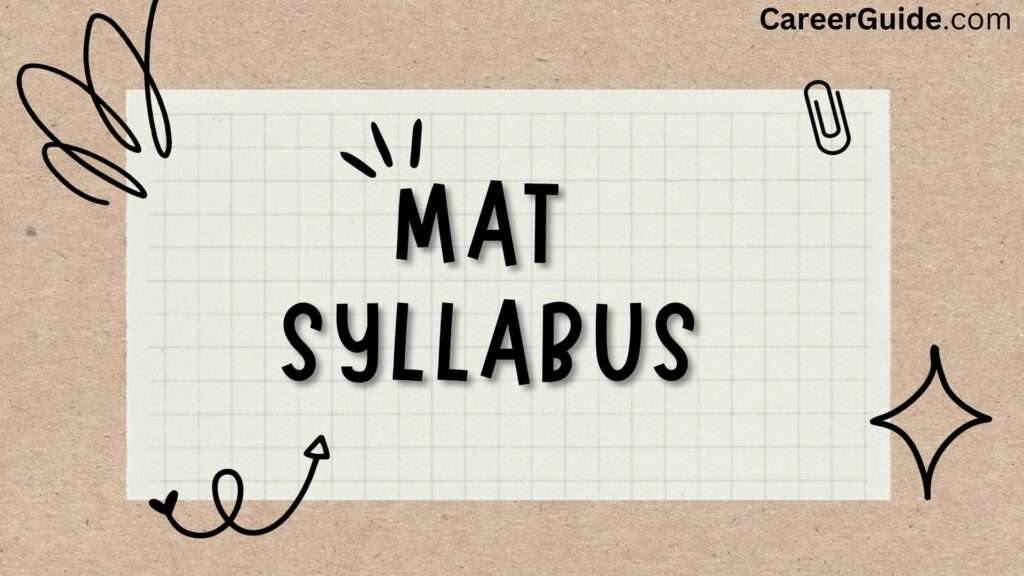MAT Syllabus: The term “MAT” can refer to different things, but one common interpretation is the “Management Aptitude Test.” MAT is a standardized test conducted in India to assess the aptitude of candidates for admission to various management programs.
It is widely accepted by many business schools and management institutes across the country. In this article, we will explore the MAT syllabus in detail, covering all the important sections and topics that candidates need to prepare for to excel in the MAT exam.

Overview of MAT Exam
The MAT exam is conducted by the All India Management Association (AIMA). It is a national-level entrance test that enables candidates to seek admission into various management programs, including MBA and PGDM, offered by various institutes and universities in India. The MAT exam is conducted four times a year, typically in February, May, September, and December.
MAT Exam Format
The MAT exam is conducted in both paper-based (offline) and computer-based (online) modes. Candidates can choose the mode that suits them best. The exam consists of five sections, each assessing different skills and aptitudes. Let’s delve into the MAT syllabus by examining each section separately.
Language Comprehension
This section evaluates a candidate’s proficiency in the English language and comprehension skills. The following topics are generally covered:
- Reading Comprehension
- Vocabulary
- Grammar
- Verbal Reasoning
- Fill in the Blanks
- Para Jumbles
- Sentence Correction
- Antonyms and Synonyms
Candidates should focus on improving their reading speed and comprehension, as well as enhancing their vocabulary and grammar skills.
Mathematical Skills
This section assesses the candidate’s mathematical ability. It includes topics such as:
- Arithmetic
- Algebra
- Geometry
- Trigonometry
- Statistics
- Modern Mathematics
- Percentage
- Profit and Loss
- Time and Work
- Number Systems
- Ratio and Proportion
Candidates need to have a strong foundation in mathematics and should practice solving various types of quantitative problems.
Data Analysis and Sufficiency
This section evaluates the candidate’s ability to interpret and analyze data. Topics covered include:
- Data Interpretation
- Data Sufficiency
- Tables
- Bar Graphs
- Pie Charts
- Line Graphs
- Caselets
- Data Comparison
- Data Sufficiency
Candidates must practice solving data-related questions and learn to work with various types of data representations.
Intelligence and Critical Reasoning
This section assesses the candidate’s logical and critical thinking skills. Topics include:
- Analytical Reasoning
- Critical Reasoning
- Logical Reasoning
- Analogies
- Series
- Blood Relations
- Directions
- Coding-Decoding
- Syllogisms
Candidates should focus on improving their analytical and reasoning abilities, as this section can be challenging.
Indian and Global Environment
This section evaluates the candidate’s awareness of current events and general knowledge. It includes topics such as:
- Current Affairs
- Business and Economics
- Sports
- Awards and Honors
- International Organizations
- History
- Geography
- Politics
- Science and Technology
Candidates should stay updated with current events and read newspapers, magazines, and books to prepare for this section.
Preparation Tips
Now that we’ve covered the MAT syllabus, here are some tips for effective preparation:
Understand the Exam Pattern: Familiarize yourself with the exam format, including the number of questions and the time allotted for each section.
Create a Study Schedule: Plan your study schedule, allocating sufficient time to each section based on your strengths and weaknesses.
Practice Regularly: Solve mock tests and previous year’s question papers to get a feel for the exam and improve your time management skills.
Improve Time Management: Since MAT is a time-bound exam, practice solving questions within the allotted time to increase your speed and accuracy.
Focus on Weak Areas: Identify your weak areas and work on them systematically to improve your overall performance.
Stay Updated: Stay informed about current events and developments, especially for the Indian and Global Environment section.
Seek Guidance: Consider enrolling in a coaching program or seeking guidance from experienced mentors if needed.
Maintain a Healthy Lifestyle: Ensure proper rest, nutrition, and exercise to stay mentally and physically fit during your preparation.
FAQs
The MAT syllabus covers five main sections: Language Comprehension, Mathematical Skills, Data Analysis and Sufficiency, Intelligence and Critical Reasoning, and Indian and Global Environment. Each section assesses different skills and aptitudes.
The MAT exam consists of 200 multiple-choice questions, divided into five sections of 40 questions each. Each section has its own time limit, and candidates can choose whether to attempt the exam in the paper-based or computer-based mode.
The Language Comprehension section includes topics like Reading Comprehension, Vocabulary, Grammar, Verbal Reasoning, Fill in the Blanks, Para Jumbles, Sentence Correction, Antonyms, and Synonyms.
The Mathematical Skills section covers topics such as Arithmetic, Algebra, Geometry, Trigonometry, Statistics, Modern Mathematics, Percentage, Profit and Loss, Time and Work, Number Systems, and Ratio and Proportion.
This section evaluates a candidate’s ability to interpret and analyze data through topics like Data Interpretation, Data Sufficiency, Tables, Bar Graphs, Pie Charts, Line Graphs, Caselets, Data Comparison, and Data Sufficiency.








